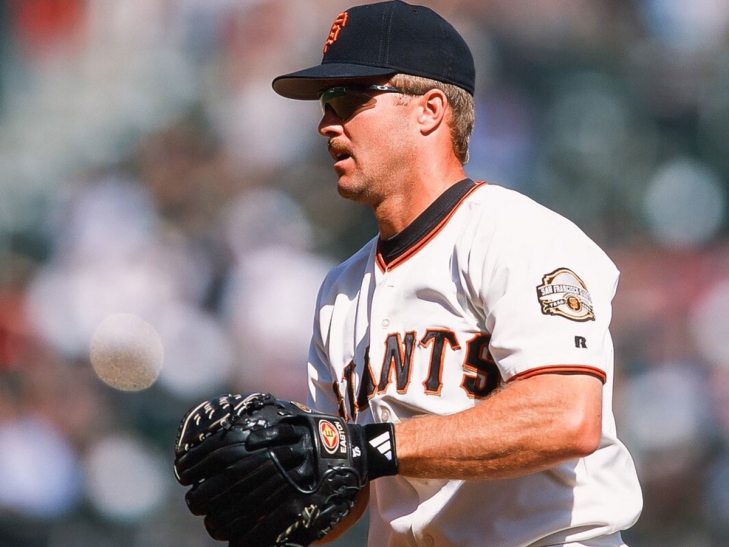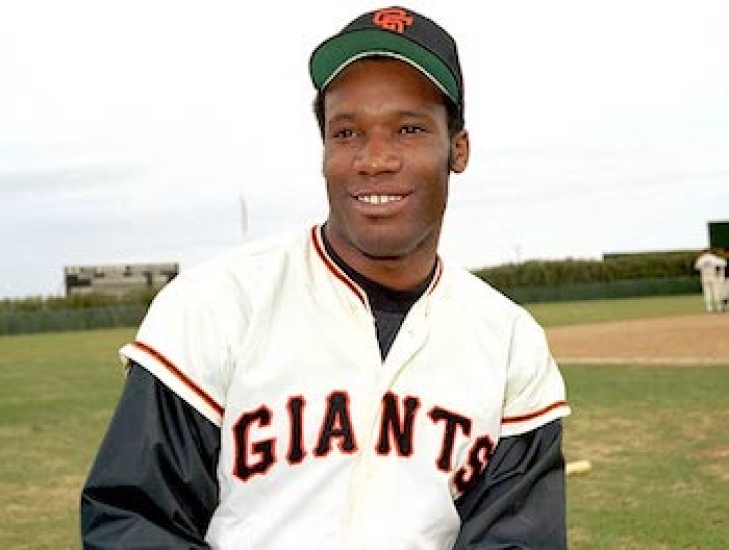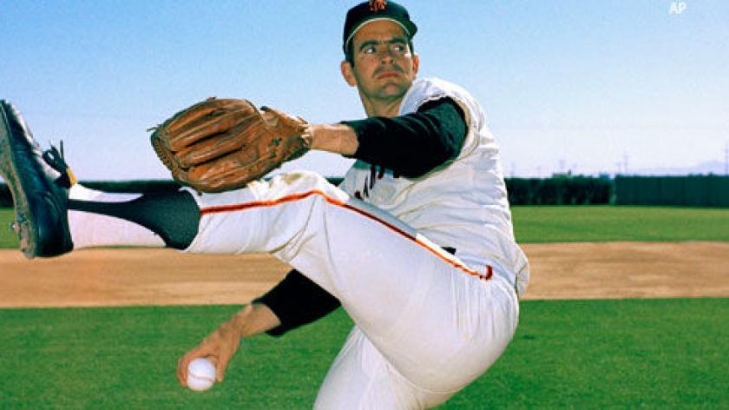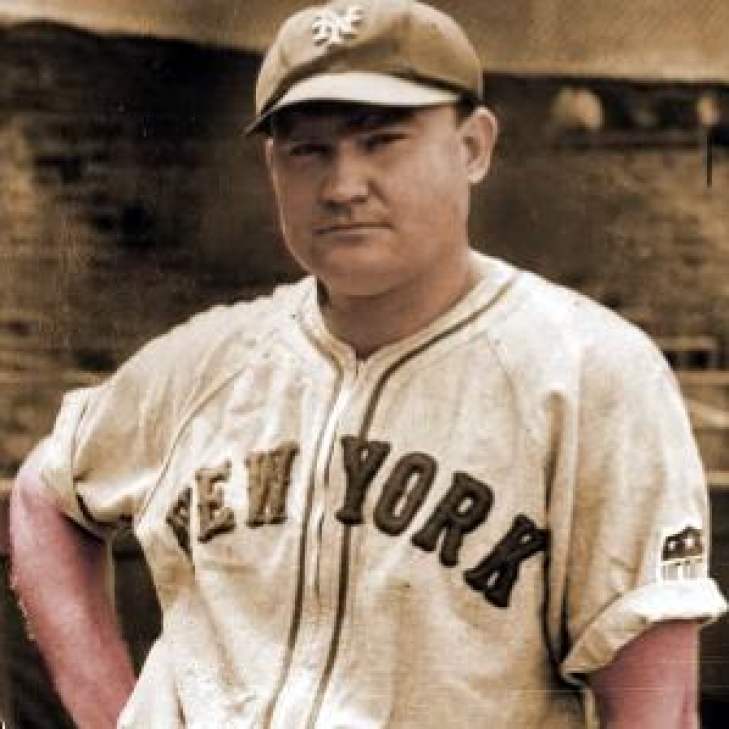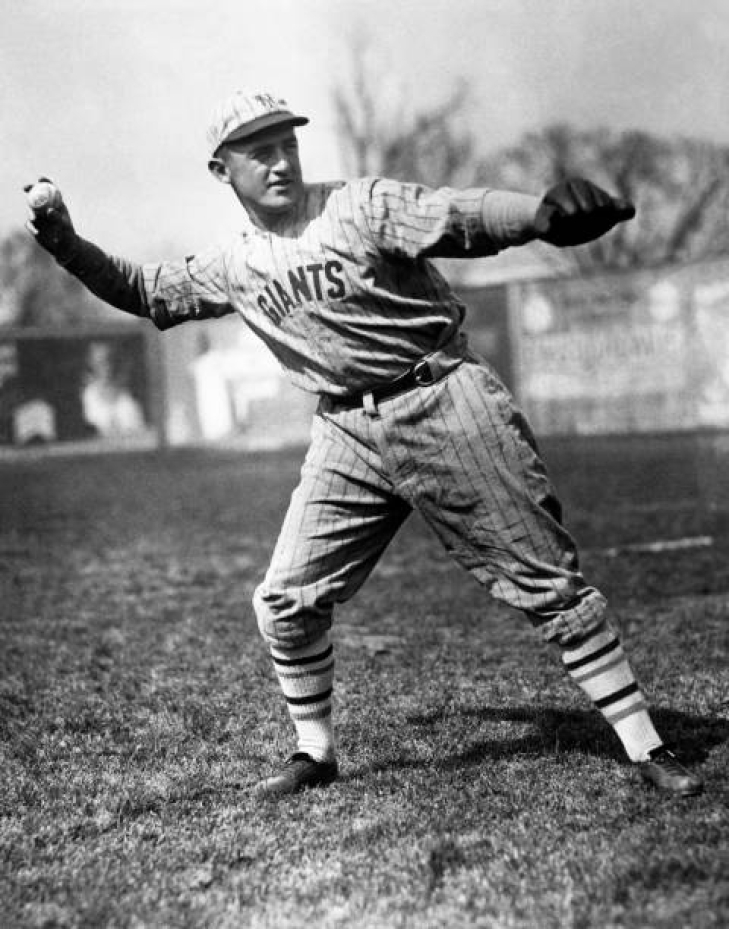48. Sal Maglie
Sal Maglie took a long time to establish himself as a Major League Pitcher, but that was not due to a lack of skill.
It took him until the age of 28 to make the big leagues, debuting for the New York Giants in 1945 after four years in their farm system. He did well, going 5-4, but he had an offer to pitch in the Mexican league for more money. Maglie took it but was subsequently banned by the Commissioner for his decision. It was a costly trip South of the Border, as the team, he signed with could not afford him for long, and he was out of the game on a professional level. Five years later, the ban was lifted, and he was back in 1950.
Nicknamed the “Barber” for his penchant for throwing balls close to the batter’s faces, Maglie had an incredible return, winning the ERA Title (2.71) with a stellar 18-4 Record. He was just as good, the next two All-Star appearing seasons, leading the NL in Wins (23) and H/9 (7.7) in 1951, finishing fourth in MVP voting. With Maglie excelling, New York won the 1951 and 1954 Pennant, winning the World Series in 1954.
Back issues took their toll on Maglie, who could not replicate his past success. He was waived by the Giants during the 1956 Season and claimed by Cleveland, and though he was never an All-Star again, he played until 1961.
As a Giant, Maglie went 95 and 42 with an ERA of 3.13.
35. Robby Thompson
From the University of Florida, Robby Thompson was taken overall in 1983 the Amateur Draft by the Giants, who made him their everyday Second Baseman three years later. It was a good rookie year for Thompson, who batted .271 and proved a competent leadoff hitter.
Thompson, who would be an All-Star twice, was a decent defensive player (he won the 1993 Gold Glove) and collected at least 110 Hits in his first seven years. His best year was in 1993, where he had career-highs in Hits (154), Doubles (30), Home Runs (19), RBIs (65), and the three Slash Line components (.312/.375/.496), and win the Silver Slugger but that would also mark the end of his elite period.
Thompson played three more years but dealt with injury after injury and only appeared in 193 Games in that period. He signed with Cleveland in 1997 but never played there. Thompson had 1,187 Hits career hits with 119 Home Runs and was part of San Francisco's inaugural Wall of Fame Class of 2008.
31. Buck Ewing
We have to go way back for this one, as Buck Ewing joined the Giants in 1883, after
A player with multiple defensive skills (he played at Catcher, Outfield, Second, and Third), Ewing began his career in the National League with Troy, where he played three seasons before the team folded, and he joined New York, the team where he became a star. Along with his defensive versatility (though he was at his best as a Catcher), Ewing was a competent hitter, batting over .300 in six of his first seven years with New York.
19th Century Baseball was not a power game, but Triples and Stolen Bases were in vogue, and Ewing could deliver. He was the league leader in Triples with 20 in 1894 and had 109 in total as a Giant. Ewing stole 178 bases on the base paths for New York, an astonishing number for a Catcher. Ewing was also a large part of the original version of the World Series, leading New York to titles in 1888 and 1889.
After 1989, Ewing was one of many players who jumped to the Players League, but with that organization lasting only one year, he was back to the Giants, playing there three more years before he was traded to Cleveland.
In 1939 Ewing was elected into the Baseball Hall of Fame by the Old Timers Committee.
36. Hal Schumacher
Hal Schumacher played his entire MLB career with the New York Giants, where he flirted with being an ace for a brief period.
Schumacher debuted in 1931 but began a three-year run in 1933, where he was a massive part of New York's success. An All-Star in 1933 and 1935, Schumacher went 19-12 with a 2.16 ERA while leading the NL in H/9 (6.9), and he would help lead the Giants to a World Series win, gaining a decision in the Fall Classic. It was his only World Series Title, but not his only good year.
In the year between his two All-Stars (1934), Schumacher had what could be considered his best regular season, at least in terms of Wins (23) and MVP voting (9th). Following 1935, Schumacher was a middle-of-the-road Starter, never winning more than 13 Games, though he was far from a liability. He left the Majors for the American Military in World War II, missing three years (1943-45), and returned for one last season in 1946.
Overall, Schumacher had a record of 158-121 with a 3.36 ERA.
22. Art Fletcher
Art Fletcher is thought of more by baseball pundits for his time as a Coach for the New York Yankees, but as a player, he is arguably the greatest defensive player in Giants history.
Holding the franchise record for Defensive bWAR (25.9) and a three-time league leader in that stat, Fletcher was also first in Assists four times. Offensively, Fletcher was no star, but he accumulated 1,311 hits, batted .275 for New York, and mastered the selfless art of being hit by pitches, leading the NL in that statistic four times.
The Giants made the World Series (though lost) with Fletcher as their Shortstop four times. You have to be a pretty good ballplayer to be a starting Shortstop for that to happen.
33. Brandon Crawford
Brandon Crawford has to date played his entire career with the San Francisco Giants, a team he debuted for in 2011.
Playing at Shortstop, Crawford has been excellent defensively, winning four Gold Gloves and two Wilson Defensive Awards, but he has been capable offensively too. Crawford became the sixth player to blast a Grand Slam in his first MLB Game, and the three-time All-Star has twice hit at least 20 HR in a year.
Crawford led the NL in Triples in 2016, and in 2021, he had his best year in Baseball, with a 24 HR/.298 BA year, where he was fourth in MVP voting.
Crawford slowed down considerably in 2022, and he left for the Cardinals in 2024 via free agency. With the Giants, Crawford accumulated 1,392 Hits and 146 Home Runs.
30. Jeff Kent
Jeff Kent was often a controversial figure, like the man he often batted ahead of (Barry Bonds), though the Giants had no idea that might be the case. He also exceeded all of their expectations, which makes the occasional headache worthwhile.
The Second Baseman had not accomplished much in the Majors, and though he was an everyday player, he was not a superstar. This all changed on the West Coast, with Kent belting at least 23 Home Runs and 101 RBIs and all six of his San Francisco seasons. An All-Star from 1999 to 2001, and Silver Slugger from 2000 to 2002, Kent won the MVP over his teammate, Bonds, in 2000 and was the beneficiary of his place in the lineup. Kent and Bonds did not get along, but they co-existed, allowing for one of the most potent hearts of a batting order in the early 2000s.
When Kent was a Free Agent, he left for Houston, leaving behind 1,021 Hits, 175 Home Runs, and a .903 OPS. In 2009, Kent was the lone induction into the Giants Wall of Fame.
45. Larry Jensen
World War II delayed Larry Jansen from achieving his Major League Baseball dream, as he did not make it until 1947 when he was 27. He went 21-5 with a 3.16 ERA and a league-leading 2.1 BB/9, and probably would have won the Rookie of the Year had not a man who had to wait to play in the Majors for a different reason, Jackie Robinson, not been around.
Jansen remained a top Pitcher for New York, going to the All-Star Game in both 1950 and 1951, with the former year seeing the righthander lead the NL in WHIP (1.065) and Wins (23) in the latter. In both '50 and '51, Jansen topped the NL in SO/BB.
Issues with his throwing arm began to creep in, and after two below-average seasons, he barely played in 1954 and was released that year. Jansen had a good, though forgotten run, posting a record of 120-86 with 826 Strikeouts.
29. Ross Youngs
Playing his entire career with the New York Giants, Ross Youngs had the affable nickname of "Pep" due to his playing style, which made him popular among fans and teammates.
Youngs made it to the Majors with New York late in 1917 and was penciled in as a starting Outfielder the year after. Emerging as one of the better contact hitters, Youngs strung together a seven-year streak of batting over .300, twice going over .350; though he never won a Batting or On Base Percentage Title, he was in the hunt for many and twice led the NL in Times on Base.
Defensively, Youngs was also a decent player, though he was a four-time position leader in Errors and a five-time position leader in Assists. His overall play and positive attitude helped the Giants win the 1921 and 1921 World Series.
Youngs career was sadly cut short in 1926 following a kidney disease that would take his life a year later at age 30.
Youngs was a Hall of Fame selection by the Veteran’s Committee in 1972, though it was considered controversial, as any of his former teammates were on the committee. Regardless, he has that plaque in Cooperstown.
24. Bobby Bonds
The father of the eventual Home Run King, Barry Bonds, Bobby Bonds, was one hell of a baseball player himself and the first man with that surname to be an All-Star in San Francisco.
Bonds debuted for the Giants in 1966, and before long, we had the prototype for the Power-Speed # statistic (which he led nine times, five as a Giant) that would come in vogue decades later. The speedy Rightfielder stole bases the same way he went deep, which was often. Bonds became the first player to have a 30 Home Run/30 Stolen Base year, and he would do so five times! An All-Star twice in San Francisco, Bonds became a new type of leadoff hitter who could set the table and clear it with the same ease. Defensively, he was also very good, winning three Gold Gloves.
Bonds, who would become the second player behind his teammate, Willie Mays, to have 300 Home Runs and 300 Stolen Bases, was traded to the Yankees in 1974. Bonds collected 1,106 Hits with 186 Home Runs and 263 Stolen Bases as a Giant.
In 2008, Bonds was part of San Francisco's first Wall of Fame Class.
25. Gaylord Perry
Gaylord Perry spent more time with the San Francisco Giants (ten years) than he did with any other team, but the Cooperstown resident is not one of the first Pitchers you think of when the story of the Giants is discussed. Perhaps, that is because he won his two Cy Young Awards elsewhere (Cleveland and San Diego), but it was in SF where he became a star.
The spitball master did not learn that trick pitch right away. He first debuted for San Francisco in 1962, mostly coming in from the bullpen, and he did not stick in the Majors until 1964, the same year he adopted the spitter.
Perry had his break-out year in 1966, finishing 21-8 with an ERA of 2.99. He went to his first All-Star Game and fanned 201 batters, the first of four times he struck out at least 200. Now the ace of the staff (or at least at the top of the rotation), Perry kept compiling good numbers, keeping his ERA under three for the most part, while also leading the NL twice in Innings Pitched (1969 & 1970). His best season as a Giant was in 1970 when he was again an All-Star and led the NL in Wins (23). Perry was second in Cy Young voting that year.
Perry was an outstanding hurler, but the Giants thought that at age 33, his best years were behind him. He was traded to Cleveland and promptly proved that San Francisco was wrong, and it remains one of the worst trades in franchise history.
Perry had 1606 Strikeouts with a 134-109 Record with the Giants, and he entered the Baseball Hall of Fame in 1991. San Francisco retired his number 36 in 2005, and three years later, he was part of the monstrous first class of their Wall of Fame.
28. Orlando Cepeda
From Puerto Rico, Orlando Cepeda was one of the first baseball superstars from the Caribbean Island, which continues to produce some of the best players to this day.
Cepeda joined the Giants in 1958, the franchise's first year in San Francisco, and he was the first Giant star to begin his career on the West Coast. Winning the National League Rookie of the Year in a unanimous vote, Cepeda led the league in Doubles (38), smacked 25 Home Runs, and batted .312.
This man was no one-year wonder, as Cepeda then went off on a six-year All-Star streak, all in seasons that he would at least belt 24 Home Runs and bat over .297. Cepeda batted over .300 six times in San Francisco, winning the Home Run Title in 1961 (46) and the RBI Title (142), and was second to Frank Robinson for the MVP.
Cepeda suffered a knee injury in Winter Ball in 1963, but he powered through it to the point where fans had no idea he was in constant pain. It was not for two years later that he had to take time off, but he was awful, batting well under .200 with one Home Run in 34 Games. He would return to the regular lineup in 1966, but he was not the same player and was traded to the St. Louis Cardinals during the season.
As a Giant, Cepeda batted .308 with 1,286 Hits and 226 Home Runs.
Cepeda entered the Baseball Hall of Fame as a Veteran's Committee entrant in 1999, and San Francisco responded that year by retiring his number 30. He was also part of the Giants first Wall of Fame group in 2008.
27. Johnny Antonelli
Johnny Antonelli received one of the biggest bonuses ($52,000) when the Milwaukee Braves signed the high school star in 1948. It caused resentment in the Braves locker room, so much so that fellow hurler Johnny Sain pushed for Antonelli to be blackballed from the loser's share of the 1948 World Series purse. He would get his share ($571.31) when the Commissioner intervened, but Antonelli was always on the outside looking in. After spending time in the military, another Braves star, Warren Spahn, convinced management that Antonelli was expendable as they had "too many lefthanders," and he was traded to New York, where he thrived as a Giant.
Antonelli had to have a chip on his shoulder, and the new scenery was just what the doctor ordered. His first season as a Giant was his best, going 21-7, while he led the NL in ERA (2.30) and ERA+ (178) and went 21-7 with a third-place finish in MVP voting, and was The Sporting News Pitcher of the Year (the Cy Young didn't exist yet). It was a perfect end to the year, as Antonelli helped the Giants win the World Series.
An All-Star six times as a Giant, Antonelli was entrenched throughout the rest of the 1950s at or near the top of New York (then San Francisco) rotation. The Giants, and Antonelli for that matter, did not have a year like '54 over the rest of his run for that team, but he was still a very good pitcher with a record of 108-84 with a 3.13 ERA for the team.
Antonelli was traded to Cleveland after the 1959 Season, and he was out of Baseball less than two years later. He might not have been worth his bonus, but it was the best bonus the Giants never paid.
26. Joe McGinnity
Joe McGinnity was initially called the "Iron Man" due to working in an iron foundry in the off-season. It would later become more appropriate to refer to his durability on the mound.
McGinnity debuted in the Majors first with Brooklyn, where he led the league in Wins in his rookie and sophomore years. Jumping to Baltimore Orioles of the upstart American League in 1901, following his Manager John McGraw, he would do so again in 1902, when the Orioles collapsed, and McGraw took over running the New York Giants. This is where McGinnity took his nickname to its logical conclusion.
The right-hander was one of the most dominant forces in the 1900s and certainly one with the highest workload. McGinnity again led the NL in Wins three more times and helped New York win the 1905 World Series. Under the shadow of Christy, Mathewson was still a star in his own right, winning the ERA Title in 1904 (1.61) and appearing in the most Games of any Pitcher five years in a row (1903-07). His 434 Innings Pitched in 1903 set a National League record, which is untouchable.
Declining in 1907, a bad fever took him out for much of 1908. After the season, he returned to the minors as an owner/player/manager. McGinnity left New York with a sweet record of 151-88 and an ERA of 2.38.
The Old Timers Committee selected McGinnity to the Baseball Hall of Fame in 1946.
32. Johnny Mize
Johnny Mize was already a four-time All-Star and two-time MVP runner-up for the St. Louis Cardinals, but the New York Giants coveted the First Baseman, as their player, Babe Young, was about to serve in the military for World War II. The Giants purchased Mize's contract in 1942, and he had another good year, winning the Slugging Title (.521) and RBI Title (110) while batting .305. He was named an All-Star, but like so many, Mize had to depart for his military duty and would not return until 1946.
Mize was able to come back in 1946, and though he was in his early 30s, he was still a potent hitter and had his best power seasons in Baseball. In 1947, he was third in MVP voting, leading the NL in Runs (137), Home Runs (51), and RBIs (137) and batting over .300 for the last time in his career (.302). Mize again won the Home Run Title in 1948 (41).
As good as Mize remained, the Giants traded him to the Yankees, where he was still a capable batter and would help the Yankees win five consecutive World Series Titles (1949-53). With the Giants, he blasted 157 Home Runs with a .299 Batting Average.
Mize was finally elected into the Baseball Hall of Fame in 1981 via the Veterans Committee.
23. Matt Williams
Matt “The Bat” Williams impressed the scouts at UNLV so much that he was the Third Overall Pick in 1986, and a year later, he first made the Giants, but the first three years were a little on the ugly side.
From 1987 to 1989, Williams was strong defensively at Third and Short but had not found his hitting, batting under .200 with 34 Home Runs in 747 Playoff Appearances. The power was there, and he was helpful in San Francisco reaching the 1989 World Series, but the improvement was still needed, and Williams rose to that challenge in 1990.
Now the everyday Third Baseman, Williams, broke out with 33 Home Runs, a league-leading 122 RBIs, and an elevated Batting Average of .277. An All-Star and Silver Slugger this year, Williams smacked at least 20 Home Runs each of the next six years, including 43 in 1994, which led the league. He was also second in MVP voting in '94 and began a three-year streak of All-Star Selections. Williams also added a second Silver Slugger in 1994 and was a three-time Gold Glove winner for the Giants defensively.
San Francisco traded Williams to Cleveland in 1997, ending his run with the Giants with 247 Home Runs, 732 RBI, and 1,092 Hits. The Giants honored Willams by inducting him as a member of their inaugural Wall of Fame Class in 2008.
20. Frankie Frisch
Frankie Frisch was arguably more known for his time with his second team, the St. Louis Cardinals, but the switch-hitting infielder was a bona fide star with his first MLB Team, the New York Giants. In some statistics, he was better.
Earning the nickname of the “Fordham Flash” as a four-sport star at the university mentioned above, Frisch signed with New York in 1919 without having to spend a day in the Minors. Playing at Third and eventually moving the Second Base, Frisch was a natural baseball player, providing speed, average, and defense throughout his career.
A player on the rise in 1920, when the Giants won the World Series, Frisch broke out in 1921, batting .341, with 211 Hits and a league-leading 49 Stolen Bases. New York won the World Series again, with Frisch playing a more significant role, batting .471 in the Fall Classic.
After his 1921 campaign, Frisch never batted under .300 as Giant again with less than 20 SB, and also had a first-place finish in Hits (223) in 1923 and Runs (121) in 1924. Frisch was a superstar, but this was not an era where the players were king; the managers were. He missed a sign in a game late in the 1926 Season, and after, he was scolded in front of his teammates by the Manager, John McGraw, leading to Frisch leaving the team. He came back, but the damage was done. Frisch was traded to St. Louis for another Hall of Famer, Rogers Hornsby, who, too, had an impasse with ownership.
The Baseball Hall of Fame elected Frisch in 1947, who won two more World Series Titles with the Cardinals.
16. George Davis
After playing his first years in the Majors with the Cleveland Spiders, George Davis was traded to New York in a pre-season 1893 trade that proved beneficial to the Giants.
A versatile player who started multiple games at Shortstop, Third Base, and the Outfield, Davis' hitting flourished under the new rules of the pushed back Pitcher's mound. Davis batted over 300 over the next nine seasons, three of which saw him exceed .350. He collected over 100 RBIs three times, including a league-leading 135 in 1897. Like many of the other players of his era, Davis was an excellent base stealer, swiping 357 bags of his 619 as a Giant.
Davis would jump to the Chicago White Sox of the American League before the 1902 Season, playing there a season before being forced to return in 1903 to New York, but that was a brief four Games before he was sent to the White Sox, where he closed out his career.
With New York, Davis batted .332 with 1,432 Hits.
Davis was elected to the Baseball Hall of Fame in 1998 when he was elected by the Veteran's Committee.
14. Travis Jackson
Travis Jackson played his entire career with the New York Giants (1922-36), where he was one of the best defensive players in franchise history.
Jackson played mostly at Shortstop but easily subbed in at Third Base when needed. Leading the National League three times in Defensive bWAR and finishing second three times, Jackson earned the nickname "Stonewall" for his ability to stop ground balls. While many defensive stars those days were soft with the bat, Jackson was a decent hitter, who had a lifetime Batting Average of .291, and hit 135 Home Runs. Jackson, who had four top-ten MVP finishes, helped New York win the World Series in 1933 and enabled them to appear in three more.
19. George Burns
An underappreciated player in the history of the Giants when they were in New York, George Burns was a Catcher-turned-Outfielder who made ripples with his bat and glove for the Giants in the 1910s.
Burns was first called up in 1911 and was a regular in 1913, a season where he helped New York win the Pennant and established himself as a capable leadoff man. One of four players to lead the league in Runs five times and Walks five times, Burns also led the NL in Stolen Bases twice (1914 & 1919) and would steal 334 bags in total as a Giant. Collecting 1,541 Hits and batting .290 for New York, Burns appeared in the World Series three times, winning a title in 1921.
Following New York’s ’21 Title, Burns was traded to Cincinnati, ending his run in New York, but never in the conversation about who was the Giants' best leadoff hitter ever.








